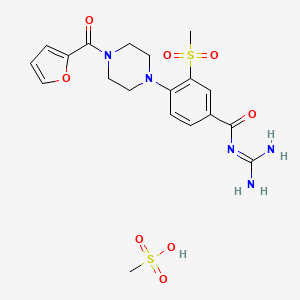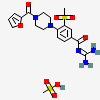Biib-513
PubChem CID
6918374
Molecular Formula
Synonyms
- BIIB-513
- Biib 513
- 265986-98-9
- UNII-Q6418LHE3S
- Q6418LHE3S
Molecular Weight
515.6 g/mol
Computed by PubChem 2.2 (PubChem release 2021.10.14)
Parent Compound
Component Compounds
Dates
- Create:2006-07-28
- Modify:2025-01-04
Chemical Structure Depiction

3D Conformer of Parent
N-(diaminomethylidene)-4-[4-(furan-2-carbonyl)piperazin-1-yl]-3-methylsulfonylbenzamide;methanesulfonic acid
Computed by Lexichem TK 2.7.0 (PubChem release 2021.10.14)
InChI=1S/C18H21N5O5S.CH4O3S/c1-29(26,27)15-11-12(16(24)21-18(19)20)4-5-13(15)22-6-8-23(9-7-22)17(25)14-3-2-10-28-14;1-5(2,3)4/h2-5,10-11H,6-9H2,1H3,(H4,19,20,21,24);1H3,(H,2,3,4)
Computed by InChI 1.0.6 (PubChem release 2021.10.14)
CIZHNWRBNREPCL-UHFFFAOYSA-N
Computed by InChI 1.0.6 (PubChem release 2021.10.14)
CS(=O)(=O)C1=C(C=CC(=C1)C(=O)N=C(N)N)N2CCN(CC2)C(=O)C3=CC=CO3.CS(=O)(=O)O
Computed by OEChem 2.3.0 (PubChem release 2024.12.12)
C19H25N5O8S2
Computed by PubChem 2.2 (PubChem release 2021.10.14)
265986-98-9
- benzamide, N-(diaminomethylene)-4-(4-(2-furanylcarbonyl)-1-piperazinyl)-3-(methylsulfonyl)-
- benzamide-N-(aminoiminomethyl)-4-(4-(2-furanylcarbonyl)-1-piperazinyl)-3-(methylsulfonyl)methanesulfonate
- BIIB 513
- BIIB-513
- BIIB-513
- Biib 513
- 265986-98-9
- UNII-Q6418LHE3S
- Q6418LHE3S
- Benzamide, N-(aminoiminomethyl)-4-(4-(2-furanylcarbonyl)-1-piperazinyl)-3-(methylsulfonyl)-, methanesulfonate (1:1)
- Benzamide, N-(aminoiminomethyl)-4-(4-(2-furanylcarbonyl)-1-piperazinyl)-3-(methylsulfonyl)-, monomethanesulfonate
- Benzamide, N-(diaminomethylene)-4-(4-(2-furanylcarbonyl)-1-piperazinyl)-3-(methylsulfonyl)-
- N-(diaminomethylidene)-4-[4-(furan-2-carbonyl)piperazin-1-yl]-3-methylsulfonylbenzamide;methanesulfonic acid
- AKOS040747973
- benzamide-N-(aminoiminomethyl)-4-(4-(2-furanylcarbonyl)-1-piperazinyl)-3-(methylsulfonyl)methanesulfonate
- HY-125144
- Q27287037
Property Name
Property Value
Reference
Property Name
Molecular Weight
Property Value
515.6 g/mol
Reference
Computed by PubChem 2.2 (PubChem release 2021.10.14)
Property Name
Hydrogen Bond Donor Count
Property Value
3
Reference
Computed by Cactvs 3.4.8.18 (PubChem release 2021.10.14)
Property Name
Hydrogen Bond Acceptor Count
Property Value
9
Reference
Computed by Cactvs 3.4.8.18 (PubChem release 2021.10.14)
Property Name
Rotatable Bond Count
Property Value
4
Reference
Computed by Cactvs 3.4.8.18 (PubChem release 2021.10.14)
Property Name
Exact Mass
Property Value
515.11445512 Da
Reference
Computed by PubChem 2.2 (PubChem release 2021.10.14)
Property Name
Monoisotopic Mass
Property Value
515.11445512 Da
Reference
Computed by PubChem 2.2 (PubChem release 2021.10.14)
Property Name
Topological Polar Surface Area
Property Value
223 Ų
Reference
Computed by Cactvs 3.4.8.18 (PubChem release 2021.10.14)
Property Name
Heavy Atom Count
Property Value
34
Reference
Computed by PubChem
Property Name
Formal Charge
Property Value
0
Reference
Computed by PubChem
Property Name
Complexity
Property Value
846
Reference
Computed by Cactvs 3.4.8.18 (PubChem release 2021.10.14)
Property Name
Isotope Atom Count
Property Value
0
Reference
Computed by PubChem
Property Name
Defined Atom Stereocenter Count
Property Value
0
Reference
Computed by PubChem
Property Name
Undefined Atom Stereocenter Count
Property Value
0
Reference
Computed by PubChem
Property Name
Defined Bond Stereocenter Count
Property Value
0
Reference
Computed by PubChem
Property Name
Undefined Bond Stereocenter Count
Property Value
0
Reference
Computed by PubChem
Property Name
Covalently-Bonded Unit Count
Property Value
2
Reference
Computed by PubChem
Property Name
Compound Is Canonicalized
Property Value
Yes
Reference
Computed by PubChem (release 2021.10.14)
Follow these links to do a live 2D search or do a live 3D search for this compound, sorted by annotation score. This section is deprecated (see here for details), but these live search links provide equivalent functionality to the table that was previously shown here.
Same Parent, Exact Count
Mixtures, Components, and Neutralized Forms Count
Similar Compounds (2D)
Similar Conformers (3D)
Same Count
PubMed Count
Sodium Channel Blockers
A class of drugs that act by inhibition of sodium influx through cell membranes. Blockade of sodium channels slows the rate and amplitude of initial rapid depolarization, reduces cell excitability, and reduces conduction velocity. (See all compounds classified as Sodium Channel Blockers.)
Patents are available for this chemical structure:
https://patentscope.wipo.int/search/en/result.jsf?inchikey=CIZHNWRBNREPCL-UHFFFAOYSA-N
- ChemIDplusChemIDplus Chemical Information Classificationhttps://pubchem.ncbi.nlm.nih.gov/source/ChemIDplus
- FDA Global Substance Registration System (GSRS)LICENSEUnless otherwise noted, the contents of the FDA website (www.fda.gov), both text and graphics, are not copyrighted. They are in the public domain and may be republished, reprinted and otherwise used freely by anyone without the need to obtain permission from FDA. Credit to the U.S. Food and Drug Administration as the source is appreciated but not required.https://www.fda.gov/about-fda/about-website/website-policies#linking
- Comparative Toxicogenomics Database (CTD)LICENSEIt is to be used only for research and educational purposes. Any reproduction or use for commercial purpose is prohibited without the prior express written permission of NC State University.http://ctdbase.org/about/legal.jsp
- Therapeutic Target Database (TTD)
- Springer Nature
- Wikidata
- PubChem
- Medical Subject Headings (MeSH)LICENSEWorks produced by the U.S. government are not subject to copyright protection in the United States. Any such works found on National Library of Medicine (NLM) Web sites may be freely used or reproduced without permission in the U.S.https://www.nlm.nih.gov/copyright.htmlSodium Channel Blockershttps://www.ncbi.nlm.nih.gov/mesh/68026941
- PATENTSCOPE (WIPO)SID 389594717https://pubchem.ncbi.nlm.nih.gov/substance/389594717
CONTENTS


 CID 6918375 (BIIB-513 free base)
CID 6918375 (BIIB-513 free base) CID 6395 (Methanesulfonic Acid)
CID 6395 (Methanesulfonic Acid)